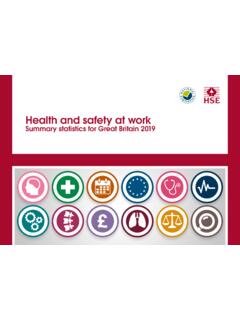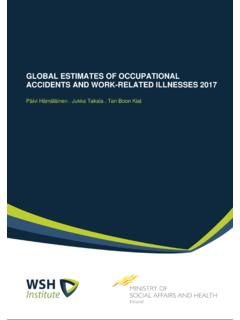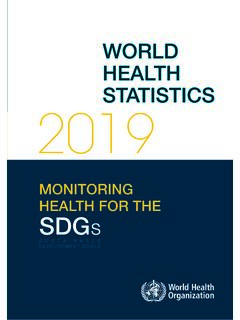Transcription of Disparities in the risk and outcomes of COVID-19
1 Disparities in the risk and outcomes of COVID-19 Disparities in the risk and outcomes from COVID-19 2 About Public Health England Public Health England exists to protect and improve the nation s health and wellbeing and reduce health inequalities. We do this through world-leading science, research, knowledge and intelligence, advocacy, partnerships and the delivery of specialist public health services. We are an executive agency of the Department of Health and Social Care, and a distinct delivery organisation with operational autonomy. We provide government, local government, the NHS, Parliament, industry and the public with evidence-based professional, scientific and delivery expertise and support. Public Health England Wellington House 133-155 Waterloo Road London SE1 8UG Tel: 020 7654 8000 Twitter: @PHE_uk Facebook: Prepared by: Epi cell, Surveillance cell and Health Intelligence team For queries relating to this document, please contact: Crown copyright 2020 You may re-use this information (excluding logos) free of charge in any format or medium, under the terms of the Open Government Licence To view this licence, visit OGL.
2 Where we have identified any third party copyright information you will need to obtain permission from the copyright holders concerned. Published August 2020 PHE publications PHE supports the UN gateway number: GW-1447 Sustainable Development Goals Disparities in the risk and outcomes from COVID-19 3 Contents Executive summary 4 Acknowledgements 9 1. Age and sex 10 2. Geography 20 3. Deprivation 32 4. Ethnicity 39 5. Occupation 50 6. Inclusion health groups 54 7. Deaths in care homes 57 8. Comorbidities 60 9. Limitations 66 10. Data sources and methodologies 69 11. References 76 Appendices 81 Disparities in the risk and outcomes from COVID-19 4 Executive summary This is a descriptive review of data on Disparities in the risk and outcomes from COVID- 19.
3 This review presents findings based on surveillance data available to PHE at the time of its publication, including through linkage to broader health data sets. It confirms that the impact of COVID-19 has replicated existing health inequalities and, in some cases, has increased them. These results improve our understanding of the pandemic and will help in formulating the future public health response to it. The largest disparity found was by age. Among people already diagnosed with COVID- 19, people who were 80 or older were seventy times more likely to die than those under 40. Risk of dying among those diagnosed with COVID-19 was also higher in males than females; higher in those living in the more deprived areas than those living in the least deprived; and higher in those in Black, Asian and Minority Ethnic (BAME) groups than in White ethnic groups.
4 These inequalities largely replicate existing inequalities in mortality rates in previous years, except for BAME groups, as mortality was previously higher in White ethnic groups. These analyses take into account age, sex, deprivation, region and ethnicity, but they do not take into account the existence of comorbidities, which are strongly associated with the risk of death from COVID-19 and are likely to explain some of the differences. When compared to previous years, we also found a particularly high increase in all cause deaths among those born outside the UK and Ireland; those in a range of caring occupations including social care and nursing auxiliaries and assistants; those who drive passengers in road vehicles for a living including taxi and minicab drivers and chauffeurs; those working as security guards and related occupations; and those in care homes.
5 These analyses do not take into account the existence of comorbidities, which are strongly associated with the risk of death from COVID-19 and could explain some of these differences. When this data was analysed, the majority of testing had been offered to those in hospital with a medical need. Confirmed cases therefore represent the population of people with severe disease, rather than all of those who get infected. This is important because Disparities between diagnoses rates may reflect differences in the risk of getting the infection, in presenting to hospital with a medical need and in the likelihood of being tested. Some analyses outlined in this review are provisional and will continue to be improved. Further work is planned to obtain, link and analyse data that will complement these analyses.
6 Disparities in the risk and outcomes from COVID-19 5 The results of this review need to be widely discussed and considered by all those involved in and concerned with the national and local response to COVID-19 . However, it is already clear that relevant guidance, certain aspects of recording and reporting of data, and key policies should be adapted to recognise and wherever possible mitigate or reduce the impact of COVID-19 on the population groups that are shown in this review to be more affected by the infection and its adverse outcomes . As the numbers of new COVID-19 cases decrease, monitoring the infection among those most at risk will become increasingly important. It seems likely that it will be difficult to control the spread of COVID-19 unless these inequalities can be addressed.
7 Age and sex COVID-19 diagnosis rates increased with age for both males and females. When compared to all cause mortality in previous years, deaths from COVID-19 have a slightly older age distribution, particularly for males. Working age males diagnosed with COVID-19 were twice as likely to die as females. Among people with a positive test, when compared with those under 40, those who were 80 or older were seventy times more likely to die. These are the largest Disparities found in this analysis and are consistent with what has been previously reported in the UK. These Disparities exist after taking ethnicity, deprivation and region into account, but they do not account for the effect of comorbidities or occupation, which may explain some of the differences.
8 Geography The regional pattern in diagnoses rates and death rates in confirmed cases among males were similar. London had the highest rates followed by the North West, the North East and the West Midlands. The South West had the lowest. For females the North East and the North West had higher diagnosis rates than London, while London had the highest death rate. Local authorities with the highest diagnoses and death rates are mostly urban. Death rates in London from COVID-19 were more than 3-times higher than in the region with the lowest rates, the South West. This level of inequality between regions is much greater than the inequalities in all cause mortality rates in previous years. Disparities in the risk and outcomes from COVID-19 6 Deprivation People who live in deprived areas have higher diagnosis rates and death rates than those living in less deprived areas.
9 The mortality rates from COVID-19 in the most deprived areas were more than double the least deprived areas, for both males and females. This is greater than the inequality seen in mortality rates in previous years, indicating greater inequality in death rates from COVID-19 . High diagnosis rates may be due to geographic proximity to infections or a high proportion of workers in occupations that are more likely to be exposed. Poor outcomes from COVID-19 infection in deprived areas remain after adjusting for age, sex, region and ethnicity, but the role of comorbidities requires further investigation. Ethnicity People from Black ethnic groups were most likely to be diagnosed. Death rates from COVID-19 were highest among people of Black and Asian ethnic groups.
10 This is the opposite of what is seen in previous years, when the mortality rates were lower in Asian and Black ethnic groups than White ethnic groups. Therefore, the disparity in COVID-19 mortality between ethnic groups is the opposite of that seen in previous years. An analysis of survival among confirmed COVID-19 cases and using more detailed ethnic groups, shows that after accounting for the effect of sex, age, deprivation and region, people of Bangladeshi ethnicity had around twice the risk of death than people of White British ethnicity. People of Chinese, Indian, Pakistani, Other Asian, Black Caribbean and Other Black ethnicity had between 10 and 50% higher risk of death when compared to White British. These analyses did not account for the effect of occupation, comorbidities or obesity.















